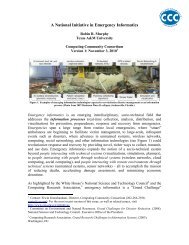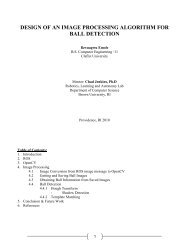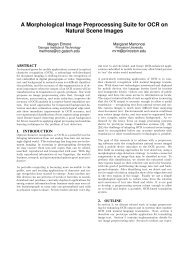High Performance Microchip Supply - Under Secretary of Defense ...
High Performance Microchip Supply - Under Secretary of Defense ...
High Performance Microchip Supply - Under Secretary of Defense ...
You also want an ePaper? Increase the reach of your titles
YUMPU automatically turns print PDFs into web optimized ePapers that Google loves.
_________________________________________________________________ APPENDIX D<br />
Past investments in research would appear to secure Moore’s Law<br />
scaling through 2009 or 2011. However, beyond that, the microchip<br />
industry faces three key challenges, each <strong>of</strong> which puts DOD’s<br />
information superiority at risk, but also poses opportunities for DOD<br />
to tilt the economics <strong>of</strong> non-standard (e.g., low volume) microchip<br />
manufacturing in its favor:<br />
There is a significant technology gap in the 2013-<br />
2019 time frame, as transistor critical dimensions<br />
shrink below 10-12 nm. While the continued use <strong>of</strong><br />
charge-based devices (devices based on the<br />
movement <strong>of</strong> electrons) remains feasible during this<br />
period, there is an urgent need for revolutionary<br />
approaches to development new operating<br />
principles and materials for use in those devices.<br />
Surprisingly, very little <strong>of</strong> the U.S. government’s<br />
National Nanotechnology Initiative (NNI) is<br />
addressing this issue – yet the window for the timely<br />
conduct and insertion <strong>of</strong> such research is rapidly<br />
closing. The need for new technologies for use in ten<br />
years may also present an opportunity to contain the<br />
capital costs associated with microchip<br />
manufacturing. For example, one alternative that<br />
has been suggested involves the use <strong>of</strong> chemical<br />
processes to create nano-wire / nano-dot devices in<br />
bulk and to use self-assembly techniques to create<br />
small clusters <strong>of</strong> “pre-wired” devices and precisely<br />
position them on a microchip substrate. Taking this<br />
line <strong>of</strong> reasoning a step further, it may be possible to<br />
use what would then be “legacy” 10-20 nm<br />
lithography technology to wire together these selfassembled<br />
clusters. Since the “legacy” lithography<br />
and associated mask-making equipment would by<br />
then have been substantially depreciated, the capital<br />
equipment costs associated with such a<br />
manufacturing approach might not be as prohibitive<br />
to the DOD as they are today. Direct imprint<br />
lithography is another alternative that is being<br />
HIGH PERFORMANCE MICROCHIP SUPPLY ___________________________________________<br />
89
















